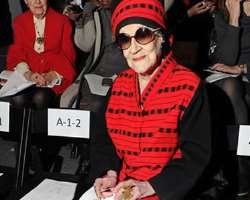A Manhattan Fashion Icon Is There Until The End

ZELDA KAPLAN exited this world much as she had lived in it, an inimitable fixture on fashion’s front lines.
In June she danced the night away at her 95th birthday party at the Gramercy Park Hotel. Last month she was photographed at the opening of the XL club with fellow revelers, including Lance Bass and the designer and stylist Indashio. And only Wednesday she took her customary front-row seat at the fashion show of her longtime friend, the designer Joanna Mastroianni.
Midway through the proceedings, she collapsed and was carried from the room by security guards. Shortly thereafter she was pronounced dead at St. Luke’s-Roosevelt Hospital.
In a statement, Ms. Mastroianni lamented the loss of one of New York’s oldest and best-loved night birds, who was, in her phrase, “an icon of the fashion community.”
“She had such a love of life and believed in living every day to the fullest,” she said.
Her passing will indeed leave a void on the New York social circuit, where Ms. Kaplan was affectionately known as the woman who could out-party even Paris Hilton.
“When Zelda was in the room, you knew it was an occasion,” said Patrick McDonald, a writer for Paper magazine and style-world habitué. “Her lust for life was unbelievable. She signified that you could be yourself whatever your age and enjoy every moment of it.”
Ms. Kaplan could readily be picked out in a roomful of Manhattan glitterati by the amused smile that complemented her exuberant ensemble. On evenings out, she generally wore a giddy composite of oversize glasses, bold African prints and a toque that matched her outfit, one that she invariably designed herself.
“She was an original,” Mr. McDonald said. “She never wore the same outfit twice but always had the same style. That’s what was so vivid about her.”
Among her admirers is the fashion publicist Kelly Cutrone, for whom Ms. Kaplan had long been a role model. “She pioneered a trail of fierceness for the rest of us,” Ms. Cutrone said. “Her life was the most amazing look book. Every time you would see her, she was pushing the envelope.”
Like many memorable New Yorkers, Ms. Kaplan was largely a creature of her own invention. A suburban girl, she grew up outside Flemington, N.J. But she was reticent about her private life.
“I don’t like to talk about my past,” she said, “because I was so conventional and middle class. It was boring.”
She was married twice, once for 11 months early in life, and later to a Samuel Kaplan, a doctor, with whom she never ventured much farther from her home in Miami than to Grossinger’s, the Catskills resort.
After her second divorce in the late 1960s, she moved to New York, became a ballroom dance instructor and began indulging a passion for what she called “primitive cultures,” traveling to Mali and other exotic destinations in search of the woodcarvings and fabrics from which she made her eye-catching designs.
In recent years, one of her favorite late-night haunts was Bungalow 8 in Chelsea, whose owner Amy Sacco had extended her an open invitation. Her flamboyance and gadabout ways captivated her friend, the artist Andres Serrano, who captured her spirit in a seductive photograph.
Ms. Kaplan expressed a less-frivolous side during frequent trips to remote villages in Africa, speaking to tribes about the perils of female genital cutting and lobbying for a woman’s right of inheritance. Her enthusiasm and humanitarian efforts drew the attention of the filmmakers Nicole Sampogna and Mona Eldaief, whose 2003 documentary “Her Name Is Zelda” celebrated Ms. Kaplan’s unflagging appetite for adventure.
“I’m a curious person,” Ms. Kaplan said at that time. “I want to keep learning until it’s over. And when it’s over, it’s over.”
NEW YORK TIMES
